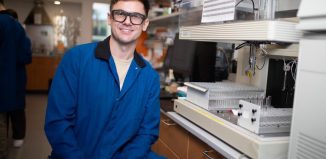SBU’s Marie Badalamente and Alexander Dagum
Using the enzyme mix in Xiaflex to treat Dupuytren’s contracture, frozen shoulders and now cellulite
It’s a nuisance during the summer months, when the weather heats up and bathing suits and shorts come out. Never a distinguishing or welcome sign, it’s the dimpled skin condition known as cellulite.
Researchers at Stony Brook University, however, believe they have come up with a possible injection-based cure. Using the same enzymes they’ve applied with frozen shoulder and Dupuytren’s contracture, a deforming hand condition that limits finger mobility, Marie Badalamente and Alexander Dagum have had some success in treating 10 patients in a first-round study of their injections.
Later this year, they expect to enter the Food and Drug Administration’s so-called Phase 2A trials, where they will continue to test their drug, called Xiaflex. They plan to advertise for study subjects and will likely test their remedy against a placebo (using something harmless as an injection that isn’t known to have any effect on cellulite).
In their first trial, their results showed promise. On average, patients saw a 77 percent reduction in cellulite one day after the injection. After six months, those patients still saw a 76 percent reduction. Side effects included soreness, black-and-blue areas and mild edema.
“This is the first properly controlled clinical trial of an injectable treatment that has a good chance to be FDA-approved,” said Badalamente in an interview.
Cellulite affects about 90 percent of women and 10 percent of men. Women have “more of these thin-strand fibers” in their thighs and buttocks, so the fat “kind of pushes up and through, although like a honeycomb of fibers,” said Badalamente, who is a professor of orthopedics. The result is this classic dimpling appearance in those areas.
“Patients flock to cosmetic plastic surgeons’ offices in search of treatments that may help them,” she said. “It’s very troubling to a women’s sense of herself.”
In a press release, Dr. Dagum, who is the interim chairman of surgery at Stony Brook School of Medicine, added that the “methods to remove cellulite are many, but none yet have been supported in medical literature to be effective or potentially usable as a standard practice.”
Through her work with other problems, like Dupuytren’s contracture and frozen shoulder, Badalamente had used the enzyme mixture in Xiaflex. Badalamente and Edward Wang, an associate professor of Orthopedics, are collaborating on the frozen shoulder treatments.
“The common thread is the presence of a substance called collagen,” Badalamente said. “In Dupuytren’s contracture, there’s an abnormal deposition [of collagen] from the palm to the fingers. There’s a normal collagen capsule around the shoulder. In frozen shoulder, there’s an adhesion of collagen that builds up.”
The enzyme mixture lyses, or dissolves, the collagen in frozen shoulder, freeing the shoulder to return to its normal range of motion. For frozen shoulder, these Phase 2A trials have just been completed. The treatment reduces the need for extended physical therapy or arthroscopy (surgery). Phase 2B trials will begin this summer or fall.
“It was readily apparent to me that this injectable drug, which is a combination of two collagenase enzymes, clearly had other uses in a class of disorders,” she explained. “The light bulb on the top of the head moment was that I knew about the microanatomy of cellulite.”
Although the studies with Xiaflex on cellulite are still in the early stages, the use of the enzyme mixture to treat Dupuytren’s contracture has been effective over a longer period of time. If, for example, it recurs years later, patients can get another injection.
“That might be the same for cellulite,” Badalamente said.
The researchers cautioned that safety always comes first in any new treatment, even with a procedure that has won FDA approval for other uses.
For the Dupuytren’s contracture, the process took about 15 years.
“That one probably took too long,” Badalamente said. “Each indication, as it comes forward, should take much less time.”
Badalamente said she sees firsthand the problems that affect patients.
“In the case of the hand, if you can image this disease affecting both of your hands, [there’s] misery,” she said. “It’s not cancer and it’s not going to kill you, but it’s gong to interfere with your function. If you see that misery and you’re able to potentially think about a therapy that’s less invasive than surgery, there’s nothing better in the world than getting a ‘Thank you’ from the patients.”
The male ensemble of Wood, Evan Teich, Josh Rothberg, Ben Rosenbach, Matthew Michael Urinak, Dennis Setteducati and Paul Velutis along with the females Jamila Sabares-Klemm, Diana Rose Becker, Audra Rizzo, Erin Raquel Garcia and Kate Cherichello all meshed together like the breech of a 16-inch battleship’s gun — another tribute to DiPietropolo.
This season-topper was yet again another exhibition of what the Engeman can mount in its unquestionable adherence to the highest norms of professionalism.
“South Pacific” will run at the Engeman Theater, 250 Main St., Northport through July 14. Call 261-2900 or go to www.engemantheater.com for tickets.






